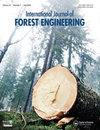Effects of traffic intensity and travel speed on forest soil disturbance at different soil moisture conditions
IF 2.1
3区 农林科学
Q2 FORESTRY
引用次数: 5
Abstract
ABSTRACT Machine traffic during wood harvesting causes damage to forest soils. Whereas increased soil damage has been associated with increased traffic frequency and soil water content, the impact of travel speed on soil disturbance, still remains unclear. We examined the effects of traffic frequency, travel speed, and soil water content on the dry bulk density, total porosity and rut depth of skidding trail soil in an Iranian temperate forest. The studied treatments included combinations of five traffic frequencies (1, 3, 7, 10, and 15 passes) of a rubber-tired skidder, three levels of travel speed (1, 3, and 5 m s−1) and two levels of soil water content (18% and 31%). The impact on soil properties was greatest during the initial skidder passes. At higher water content, only one skidder pass was required to cause substantial increases in soil bulk density compared to the control plots, at all travel speed levels. Regardless of traffic frequency and water content, a lower travel speed caused substantially greater increases in dry bulk density and greater decreases in soil porosity than did a higher travel speed. Furthermore, higher soil water content resulted in deeper ruts at all combinations of traffic intensity and travel speed. In conclusion, fewer skidder passes at a slower travel speed were required to achieve substantial soil disturbance than was the case at a faster travel speed, possibly due to the higher amount of vibration, and consequently compaction exerted during a machine pass at a slower speed.不同土壤水分条件下交通强度和行驶速度对森林土壤扰动的影响
摘要木材采伐过程中的机器运输会对森林土壤造成破坏。尽管土壤破坏的增加与交通频率和土壤含水量的增加有关,但行驶速度对土壤扰动的影响仍不清楚。我们研究了交通频率、行驶速度和土壤含水量对伊朗温带森林中打滑小道土壤干容重、总孔隙度和车辙深度的影响。所研究的处理包括橡胶疲劳集材机的五种通行频率(1、3、7、10和15次通行)、三个行驶速度水平(1、三和5 m s−1)和两个土壤含水量水平(18%和31%)的组合。对土壤性质的影响在最初的集材机道次中最大。在含水量较高的情况下,在所有行驶速度水平下,与对照地块相比,只需要一次集材机通过即可使土壤容重显著增加。无论交通频率和含水量如何,与较高的行驶速度相比,较低的行驶速度导致干体积密度显著增加,土壤孔隙度显著降低。此外,在交通强度和行驶速度的所有组合下,较高的土壤含水量都会导致更深的车辙。总之,与在较快行进速度下的情况相比,在较慢行进速度下需要较少的集材机通过来实现实质性的土壤扰动,这可能是由于较高的振动量,以及因此在较慢速度的机器通过期间施加的压实。
本文章由计算机程序翻译,如有差异,请以英文原文为准。
求助全文
约1分钟内获得全文
求助全文

 求助内容:
求助内容: 应助结果提醒方式:
应助结果提醒方式:


